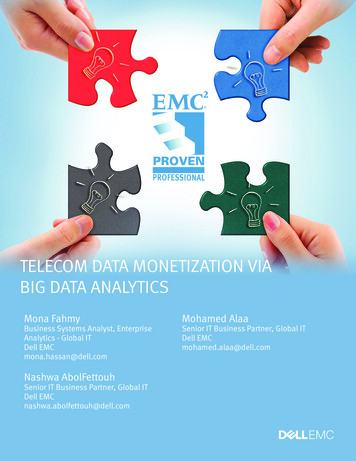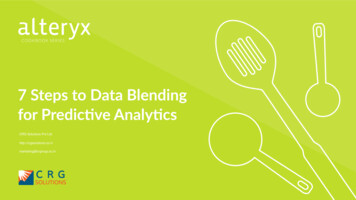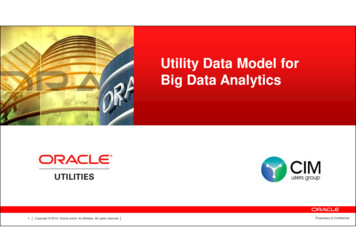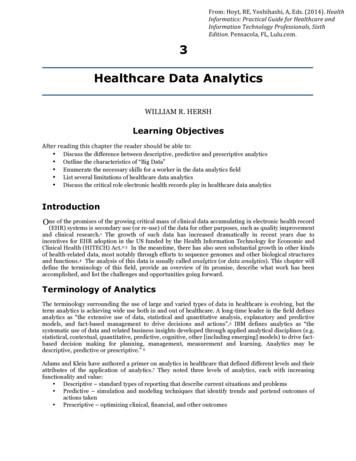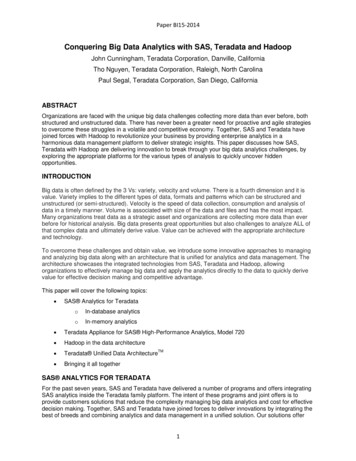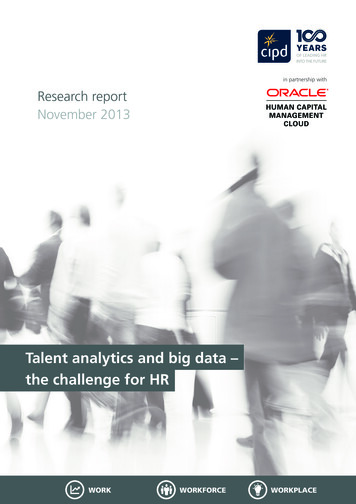
Transcription
Big Data Analytics forHealthcareJimeng SunChandan K. ReddyHealthcare Analytics DepartmentIBM TJ Watson Research CenterDepartment of Computer ScienceWayne State UniversityTutorial presentation at the SIAM InternationalConference on Data Mining, Austin, TX, 2013.The updated tutorial slides are available at http://dmkd.cs.wayne.edu/TUTORIAL/Healthcare/1
MotivationCan we learn from the past tobecome better in the future ?Healthcare Data isbecoming more complex !!In 2012, worldwide digital healthcaredata was estimated to be equal to 500petabytes and is expected to reach25,000 petabytes in 2020.Hersh, W., Jacko, J. A., Greenes, R., Tan, J., Janies, D., Embi, P. J., & Payne, P. R. (2011). Health-care hit or miss? Nature, 470(7334), 327.2
Organization of this Tutorial Introduction Motivating Examples Sources and Techniques for Big Data in Healthcare– Structured EHR Data– Unstructured Clinical Notes– Medical Imaging Data– Genetic Data– Other Data (Epidemiology & Behavioral) Final Thoughts and Conclusion3
INTRODUCTION4
Definition of Big Data A collection of large and complex data sets which are difficult to processusing common database management tools or traditional dataprocessing applications.Volume “Big data refers to the tools, processesand procedures allowing an organizationto create, manipulate, and manage verylarge data sets and storage facilities”– according to zdnet.comBig data is not just about size. Finds insights from complex, noisy,heterogeneous, longitudinal, andvoluminous data. It aims to answer questions thatwere previously unanswered.The challenges include capturing, storing,searching, sharing & analyzing.VarietyVelocityBIGDATAVeracityThe four dimensions (V’s) of Big Data5
Reasons for Growing Complexity/Abundance of Healthcare Data Standard medical practice is moving from relatively ad-hoc and subjectivedecision making to evidence-based healthcare. More incentives to professionals/hospitals to use EHR technology.Additional Data Sources Development of new technologies such as capturing devices, sensors, andmobile applications. Collection of genomic information became cheaper. Patient social communications in digital forms are increasing. More medical knowledge/discoveries are being accumulated.6
Big Data Challenges in Healthcare Inferring knowledge from complex heterogeneous patient sources.Leveraging the patient/data correlations in longitudinal records. Understanding unstructured clinical notes in the right context. Efficiently handling large volumes of medical imaging data and extractingpotentially useful information and biomarkers. Analyzing genomic data is a computationally intensive task and combiningwith standard clinical data adds additional layers of complexity. Capturing the patient’s behavioral data through several sensors; theirvarious social interactions and communications.7
Overall Goals of Big Data Analytics in HealthcareBig DataAnalyticsElectronicHealth RecordsGenomicLower costsBehavioralEvidence InsightsImproved outcomesPublic Healththrough smarter decisions Take advantage of the massive amounts of data and provideright intervention to the right patient at the right time. Personalized care to the patient. Potentially benefit all the components of a healthcare systemi.e., provider, payer, patient, and management.8
Purpose of this TutorialTwo-fold objectives: Introduce the data mining researchers to the sources available and thepossible challenges and techniques associated with using big data inhealthcare domain. Introduce Healthcare analysts and practitioners to the advancements in thecomputing field to effectively handle and make inferences from voluminousand heterogeneous healthcare data.The ultimate goal is to bridge data mining and medical informaticscommunities to foster interdisciplinary works between the two communities.PS: Due to the broad nature of the topic, the primary emphasis will be onintroducing healthcare data repositories, challenges, and concepts to datascientists. Not much focus will be on describing the details of any particulartechniques and/or solutions.9
Disclaimers Being a recent and growing topic, there might be several otherresources that might not be covered here. Presentation here is more biased towards the data scientists’perspective and may be less towards the healthcaremanagement or healthcare provider’s perspective. Some of the website links provided might become obsolete inthe future. This tutorial is prepared in early 2013. Since this topic contains a wide varieties of problems, theremight be some aspects of healthcare that might not becovered in the tutorial.10
MOTIVATING EXAMPLES11
EXAMPLE 1: Heritage Health Prizehttp://www.heritagehealthprize.com Over 30 billion was spent on unnecessary hospital admissions.Goals: Identify patients at high-risk and ensure they get the treatment they need. Develop algorithms to predict the number of days a patient will spend in ahospital in the next year.Outcomes: Health care providers can develop new strategies to care for patients beforeits too latereduces the number of unnecessary hospitalizations. Improving the health of patients while decreasing the costs of care. Winning solutions use a combination of several predictive models.12
EXAMPLE 2: Penalties for Poor Care - 30-Day Readmissions Hospitalizations account for more than 30% of the 2trillion annual cost of healthcare in the United States.Around 20% of all hospital admissions occur within 30days of a previous discharge.– not only expensive but are also potentially harmful,and most importantly, they are often preventable. Medicare penalizes hospitals that have high rates of readmissions amongpatients with heart failure, heart attack, and pneumonia. Identifying patients at risk of readmission can guide efficient resourceutilization and can potentially save millions of healthcare dollars each year. Effectively making predictions from such complex hospitalization data willrequire the development of novel advanced analytical models.13
EXAMPE 3: White House unveils BRAIN Initiative The US President unveiled a new bold 100 millionresearch initiative designed to revolutionize ourunderstanding of the human brain. BRAIN (Brain Researchthrough Advancing Innovative Neurotechnologies) Initiative. Find new ways to treat, cure, and even prevent braindisorders, such as Alzheimer’s disease, epilepsy, andtraumatic brain injury. “Every dollar we invested to map the human genome returned 140 to oureconomy. Today, our scientists are mapping the human brain to unlock theanswers to Alzheimer’s.”-- President Barack Obama, 2013 State of the Union. “advances in "Big Data" that are necessary to analyze the huge amounts ofinformation that will be generated; and increased understanding of howthoughts, emotions, actions and memories are represented in the brain .” : NSF Joint effort by NSF, NIH, DARPA, and other private ain-initiative14
EXAMPLE 4: GE Head Health ChallengeChallenge 1: Methods for Diagnosis and Prognosis of MildTraumatic Brain Injuries.Challenge 2: The Mechanics of Injury: InnovativeApproaches For Preventing And Identifying Brain Injuries.In Challenge 1, GE and the NFL will award up to 10M fortwo types of solutions: Algorithms and Analytical Tools, andBiomarkers and other technologies. A total of 60M infunding over a period of 4 years.15
Healthcare ContinuumSarkar, Indra Neil. "Biomedical informatics and translational medicine." Journal of Translational Medicine 8.1(2010): 22.16
Data Collection and AnalysisEffectively integrating and efficiently analyzing various forms of healthcare data overa period of time can answer many of the impending healthcare problems.Jensen, Peter B., Lars J. Jensen, and Søren Brunak. "Mining electronic health records: towards betterresearch applications and clinical care." Nature Reviews Genetics (2012).17
Organization of this Tutorial Introduction Motivating Examples Sources and Techniques for Big Data in Healthcare– Structured EHR Data– Unstructured Clinical Notes– Medical Imaging Data– Genetic Data– Other Data (Epidemiology & Behavioral) Final Thoughts and Conclusion18
SOURCES AND TECHNIQUESFOR BIG DATA IN HEALTHCARE19
Outline Electronic Health Records (EHR) data Healthcare Analytic Platform Resources20
ELECTRONIC HEALTHRECORDS (EHR) DATA21
DataClinical dataGenomic data Structured EHR UnstructuredEHR Medical Images DNA sequencesBehavior data Social networkdata Mobility sensordataHealthdata22
Billing data - ICD codes ICD stands for International Classification of Diseases ICD is a hierarchical terminology of diseases, signs, symptoms, andprocedure codes maintained by the World Health Organization(WHO) In US, most people use ICD-9, and the rest of world use ICD-10 Pros: Universally available Cons: medium recall and medium precision for characterizingpatients (250) Diabetes mellitus (250.0) Diabetes mellitus without mention of complication (250.1) Diabetes with ketoacidosis (250.2) Diabetes with hyperosmolarity (250.3) Diabetes with other coma (250.4) Diabetes with renal manifestations (250.5) Diabetes with ophthalmic manifestations (250.6) Diabetes with neurological manifestations (250.7) Diabetes with peripheral circulatory disorders (250.8) Diabetes with other specified manifestations (250.9) Diabetes with unspecified complication23
Billing data – CPT codes CPT stands for Current Procedural Terminology created by theAmerican Medical Association CPT is used for billing purposes for clinical services Pros: High precision Cons: Low recallCodes for Evaluation and Management: 99201-99499(99201 - 99215) office/other outpatient services(99217 - 99220) hospital observation services(99221 - 99239) hospital inpatient services(99241 - 99255) consultations(99281 - 99288) emergency dept services(99291 - 99292) critical care services 24
Lab results The standard code for lab is Logical Observation Identifiers Names and Codes(LOINC ) Challenges for lab– Many lab systems still use local dictionaries to encode labs– Diverse numeric scales on different labs Often need to map to normal, low or high ranges in order to be useful foranalytics– Missing data not all patients have all labs The order of a lab test can be predictive, for example, BNP indicates highlikelihood of heart failureTimeLabValue1996-03-15 12:50:00.0CO229.01996-03-15 12:50:00.0BUN16.01996-03-15 12:50:00.0HDL-C37.01996-03-15 12:50:00.0K4.51996-03-15 12:50:00.0Cl102.01996-03-15 12:50:00.0Gluc86.025
Medication Standard code is National Drug Code (NDC) by Food and DrugAdministration (FDA), which gives a unique identifier for each drug– Not used universally by EHR systems– Too specific, drugs with the same ingredients but different brandshave different NDC RxNorm: a normalized naming system for generic and branded drugsby National Library of Medicine Medication data can vary in EHR systems– can be in both structured or unstructured forms Availability and completeness of medication data vary– Inpatient medication data are complete, but outpatient medicationdata are not– Medication usually only store prescriptions but we are not surewhether patients actually filled those prescriptions26
Clinical notes Clinical notes contain rich and diverse source of information Challenges for handling clinical notes– Ungrammatical, short phrases– Abbreviations– Misspellings– Semi-structured information Copy-paste from other structure source– Lab results, vital signs Structured template:– SOAP notes: Subjective,Objective, Assessment,Plan27
Summary of common EHR dataICDCPTLabMedicationClinical iumPoorMediumInpatient: HighOutpatient: VariableMediumPrecisionMediumHighHighInpatient: HighOutpatient: VariableMedium ctured andunstructuredUnstructuredProsEasy to work with, agood approximationof disease statusEasy to workwith, highprecisionHigh datavalidityHigh data validityMore detailsabout doctors’thoughtsConsDisease code oftenused for screening,therefore diseasemight not be thereMissing dataDatanormalizationand rangesPrescribed notnecessary takenDifficult toprocessJoshua C. Denny Chapter 13: Mining Electronic Health Records in the Genomics Era. PLoS Comput Biol. 2012 December; 8(12):28
Analytic PlatformLarge-scale Healthcare Analytic Platform29
Analytic PlatformInformationFeaturePredictiveHealthcare AnalyticsExtractionSelectionModeling30
Analytic tructuredEHR31
Analytic tructuredEHR32
CLINICAL TEXT MINING33
Text Mining in Healthcare Text mining– Information Extraction Name Entity Recognition– Information Retrieval Clinical text vs. Biomedical text– Biomedical text: medical literatures (well-written medical text)– Clinical text is written by clinicians in the clinical settings Meystre et al. Extracting Information from Textual Documents in the Electronic Health Record: A Review of RecentResearch. IMIA 2008 Zweigenbaum et al. Frontiers of biomedical text mining: current progress, BRIEFINGS IN BIOINFORMATICS. VOL 8. NO 5.358-375 Cohen and Hersh, A survey of current work in biomedical text mining. BRIEFINGS IN BIOINFORMATICS. VOL 6. NO 1.57–71.34
Auto-Coding: Extracting Codes from Clinical Text Problem– Automatically assign diagnosis codes to clinical text Significance– The cost is approximately 25 billion per year in the US Available Data– Medical
healthcare domain. Introduce Healthcare analysts and practitioners to the advancements in the computing field to effectively handle and make inferences from voluminous and heterogeneous healthcare data. The ultimate goal is to bridge data mining and medical informatics communities to foster interdisciplinary works between the two communities.



